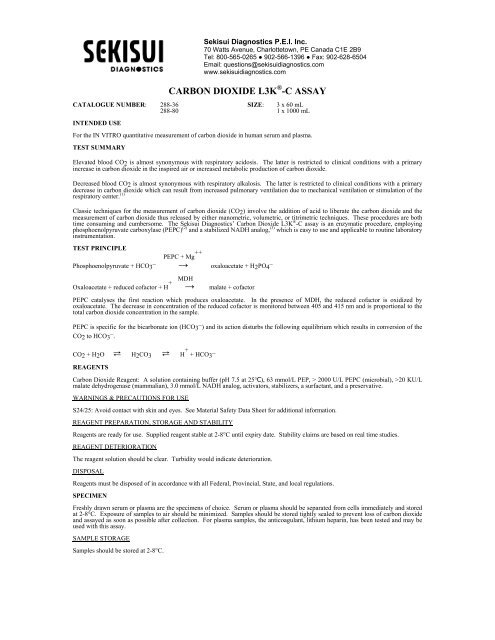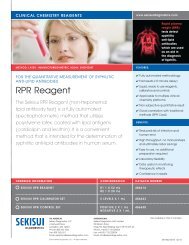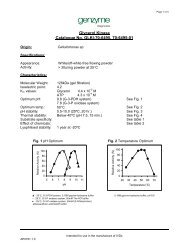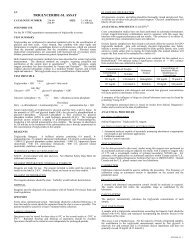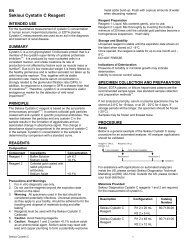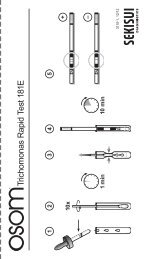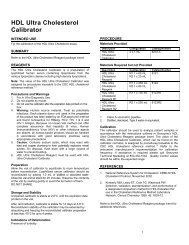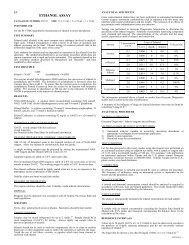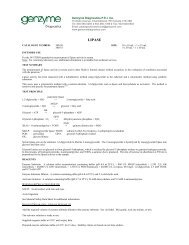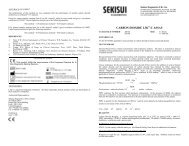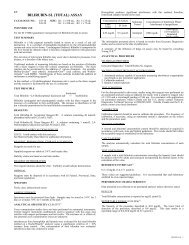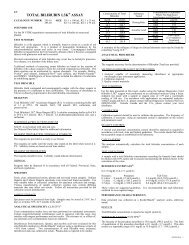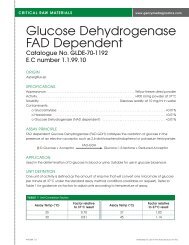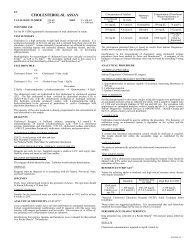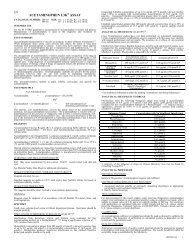CARBON DIOXIDE L3K®-C ASSAY → → - Sekisui Diagnostics
CARBON DIOXIDE L3K®-C ASSAY → → - Sekisui Diagnostics
CARBON DIOXIDE L3K®-C ASSAY → → - Sekisui Diagnostics
You also want an ePaper? Increase the reach of your titles
YUMPU automatically turns print PDFs into web optimized ePapers that Google loves.
<strong>Sekisui</strong> <strong>Diagnostics</strong> P.E.I. Inc.<br />
70 Watts Avenue, Charlottetown, PE Canada C1E 2B9<br />
Tel: 800-565-0265 ● 902-566-1396 ● Fax: 902-628-6504<br />
Email: questions@sekisuidiagnostics.com<br />
www.sekisuidiagnostics.com<br />
<strong>CARBON</strong> <strong>DIOXIDE</strong> L3K ® -C <strong>ASSAY</strong><br />
CATALOGUE NUMBER: 288-36 SIZE: 3 x 60 mL<br />
288-80 1 x 1000 mL<br />
INTENDED USE<br />
For the IN VITRO quantitative measurement of carbon dioxide in human serum and plasma.<br />
TEST SUMMARY<br />
Elevated blood CO2 is almost synonymous with respiratory acidosis. The latter is restricted to clinical conditions with a primary<br />
increase in carbon dioxide in the inspired air or increased metabolic production of carbon dioxide.<br />
Decreased blood CO2 is almost synonymous with respiratory alkalosis. The latter is restricted to clinical conditions with a primary<br />
decrease in carbon dioxide which can result from increased pulmonary ventilation due to mechanical ventilation or stimulation of the<br />
respiratory center. (1)<br />
Classic techniques for the measurement of carbon dioxide (CO2) involve the addition of acid to liberate the carbon dioxide and the<br />
measurement of carbon dioxide thus released by either manometric, volumetric, or titrimetric techniques. These procedures are both<br />
time consuming and cumbersome. The <strong>Sekisui</strong> <strong>Diagnostics</strong>’ Carbon Dioxide L3K ® -C assay is an enzymatic procedure, employing<br />
phosphoenolpyruvate carboxylase (PEPC) (2) and a stabilized NADH analog, (3) which is easy to use and applicable to routine laboratory<br />
instrumentation.<br />
TEST PRINCIPLE<br />
PEPC + Mg ++<br />
Phosphoenolpyruvate + HCO3 _ → oxaloacetate + H2PO4 _<br />
MDH<br />
Oxaloacetate + reduced cofactor + H + → malate + cofactor<br />
PEPC catalyses the first reaction which produces oxaloacetate. In the presence of MDH, the reduced cofactor is oxidized by<br />
oxaloacetate. The decrease in concentration of the reduced cofactor is monitored between 405 and 415 nm and is proportional to the<br />
total carbon dioxide concentration in the sample.<br />
PEPC is specific for the bicarbonate ion (HCO3 _ ) and its action disturbs the following equilibrium which results in conversion of the<br />
CO2 to HCO3 _ .<br />
CO2 + H2O ⇄ H2CO3 ⇄ H + + HCO3 _<br />
REAGENTS<br />
Carbon Dioxide Reagent: A solution containing buffer (pH 7.5 at 25°C), 63 mmol/L PEP, > 2000 U/L PEPC (microbial), >20 KU/L<br />
malate dehydrogenase (mammalian), 3.0 mmol/L NADH analog, activators, stabilizers, a surfactant, and a preservative.<br />
WARNINGS & PRECAUTIONS FOR USE<br />
S24/25: Avoid contact with skin and eyes. See Material Safety Data Sheet for additional information.<br />
REAGENT PREPARATION, STORAGE AND STABILITY<br />
Reagents are ready for use. Supplied reagent stable at 2-8°C until expiry date. Stability claims are based on real time studies.<br />
REAGENT DETERIORATION<br />
The reagent solution should be clear. Turbidity would indicate deterioration.<br />
DISPOSAL<br />
Reagents must be disposed of in accordance with all Federal, Provincial, State, and local regulations.<br />
SPECIMEN<br />
Freshly drawn serum or plasma are the specimens of choice. Serum or plasma should be separated from cells immediately and stored<br />
at 2-8°C. Exposure of samples to air should be minimized. Samples should be stored tightly sealed to prevent loss of carbon dioxide<br />
and assayed as soon as possible after collection. For plasma samples, the anticoagulant, lithium heparin, has been tested and may be<br />
used with this assay.<br />
SAMPLE STORAGE<br />
Samples should be stored at 2-8°C.
ANALYTICAL SPECIFICITY (CLSI EP7) (6)<br />
Cross contamination studies have not been performed on automated instruments. Certain reagent / instrument combinations used in<br />
sequence with this assay may interfere with reagent performance and test results. The existence of, or effects of, any potential cross<br />
contamination issues are unknown.<br />
Interferences from icterus, lipemia, hemolysis, and ascorbic acid were evaluated for this carbon dioxide method on a Hitachi ® 717<br />
analyzer using a significance criterion of >10% variance from control. Data for plasma is similar to that present for serum.<br />
Concentration of Analyte<br />
Conventional Units S1 Units<br />
Substance Tested<br />
Concentration of Interferent Where<br />
Interference is Insignificant<br />
30.8 mmol/L 30.8 mEq/L Hemoglobin 1000 mg/dL 155 μmol/L<br />
32.8 mmol/L 32.8 mEq/L Ascorbic Acid 3000 µg/dL 170 μmol/L<br />
32.9 mmol/L 32.9 mEq/L Bilirubin 40 mg/dL 684 μmol/L<br />
30.4 mmol/L 30.4 mEq/L Intralipid 1000 mg/dL<br />
3000 mg/dL<br />
(33.9 mmol/L)<br />
Simulated<br />
Triglycerides<br />
The information presented above is based on results from <strong>Sekisui</strong> <strong>Diagnostics</strong> studies and is current at the date of publication.<br />
A summary of the influence of drugs on clinical laboratory tests may be found by consulting Young, D.S. (4)<br />
ANALYTICAL PROCEDURE<br />
MATERIALS PROVIDED<br />
<strong>Sekisui</strong> <strong>Diagnostics</strong>’ Carbon Dioxide L3K ® -C Reagent.<br />
MATERIALS REQUIRED (BUT NOT PROVIDED)<br />
1) Automated analyzer capable of adding a system diluent and capable of accurately measuring absorbance at appropriate<br />
wavelengths as per instrument application.<br />
2) Calibration material.<br />
3) Quality Control materials.<br />
TEST CONDITION<br />
For the data presented in this insert, studies using this reagent were performed on an automated analyzer using an endpoint test mode,<br />
with a sample to reagent ratio of 1:100, and a wavelength reading of 405 nm or 415 nm. For assistance with applications on<br />
automated analyzers within Canada and the U.S., please contact <strong>Sekisui</strong> <strong>Diagnostics</strong> Technical Services at (800)565-0265. Outside<br />
Canada and the U.S., please contact your local distributor.<br />
CALIBRATION<br />
Calibration material should be used to calibrate the procedure. The frequency of calibration using an automated system is dependent<br />
on the system and the parameters used.<br />
QUALITY CONTROL<br />
A normal and abnormal concentration control should be analyzed as required in accordance with local, state and federal guidelines.<br />
The results should fall within the acceptable range as established by the laboratory.<br />
CALCULATIONS<br />
The analyzer automatically calculates the carbon dioxide concentration of each sample.<br />
TEST LIMITATIONS<br />
A sample with a carbon dioxide concentration exceeding the linearity limit should be diluted with 0.9% saline and reassayed<br />
incorporating the dilution factor in the calculation of the value.<br />
REFERENCE INTERVALS<br />
22-29 mmol/L (22-29 mEq/L) (5)<br />
These values are suggested guidelines. It is recommended that each laboratory establish its own expected range.<br />
PERFORMANCE CHARACTERISTICS<br />
Data presented was collected on Hitachi ® 717 analyzer unless otherwise stated.<br />
RESULTS<br />
Carbon Dioxide concentration is reported as mmol/L (mEq/L).<br />
REPORTABLE RANGE (CLSI EP6) (6)<br />
The linearity of the procedure described is 50.0 mmol/L (mEq/L). The lower limit of detection of the procedure described is 1.0<br />
mmol/L (mEq/L). This data results in a reportable range of 1.0-50.0 mmol/L (1.0-50.0 mEq/L).
PRECISION STUDIES (CLSI EP5) (6)<br />
Precision estimates for serum were obtained using two concentrations of control sera. Plasma based precision materials were prepared<br />
in-house and spiked to appropriate levels.<br />
Total precision was collected on two concentrations of control samples in 40 runs conducted over 20 days.<br />
Carbon<br />
Dioxide<br />
Concentration<br />
mmol/L (mEq/L)<br />
Total SD<br />
Total CV%<br />
Serum 1 13.3 0.6 4.4<br />
Serum 2 24.9 1.2 4.6<br />
Within run precision data was collected on two concentrations of control samples, each run 20 times in a single assay.<br />
Carbon<br />
Dioxide<br />
Concentration<br />
mmol/L (mEq/L)<br />
Within Run SD<br />
Within Run CV%<br />
Serum 1 13.3 0.2 1.2<br />
Serum 2 24.9 0.3 1.3<br />
Plasma 1 14.1 0.2 1.3<br />
Plasma 2 22.5 0.4 1.9<br />
ACCURACY (CLSI EP9) (6)<br />
The performance of this method (y) was compared with the performance of another carbon dioxide method (x) on a Hitachi ® 717<br />
analyzer.<br />
Forty-five serum samples ranging from 9.4 to 48.3 mmol/L (mEq/L) were tested and gave a correlation coefficient of 0.9944. Linear<br />
regression analysis gave the following equation:<br />
This method = 1.014(reference method) + 0.50 mmol/L (mEq/L).<br />
Fifty plasma samples ranging from 9.6 to 46.8 mmol/L (mEq/L) gave correlation coefficient of 0.9907. Linear regression analysis<br />
gave the following equation:<br />
REFERENCES<br />
This method = 0.973(reference method) + 0.89 mmol/L (mEq/L).<br />
1. Tietz, N.W. (Ed.), Fundamentals of Clinical Chemistry, W.B. Saunders Co., Toronto, 636-638, 937 (1970).<br />
2. Norris, K.A., Atkinson, A.R., Smith, W.G., Clin. Chem. 21 (1975).<br />
3. US Patent #5,801,006<br />
4. Young, D.S., Effects of Drugs on Clinical Laboratory Tests, AACC Press, Third Edition, Washington (1990).<br />
5. Burtis, C.A., Ashwood, E.R.T. (Editors), Tietz Textbook of Clinical Chemistry, 3 rd Edition, W.B. Saunders Company,<br />
Philadelphia (1999).<br />
6. CLSI Guidelines and Standards, Clinical and Laboratory Standards Institute, Wayne, PA.<br />
Definitions for Symbols<br />
This product fulfills the requirements of the European Directive for In<br />
Vitro Diagnostic Medical Devices.<br />
TRADEMARKS<br />
L3K is a registered trademark of <strong>Sekisui</strong>. All other trademarks, brands, product names are the property of their respective companies.<br />
Authorized Representative:<br />
<strong>Sekisui</strong> <strong>Diagnostics</strong> (UK) Limited<br />
50 Gibson Drive<br />
Kings Hill, West Malling<br />
Kent, ME19 4AF<br />
United Kingdom<br />
Tel (+44)(0)1732-220022<br />
Fax (+44)(0)1732-220024<br />
IN28830-8<br />
June 7, 2011


